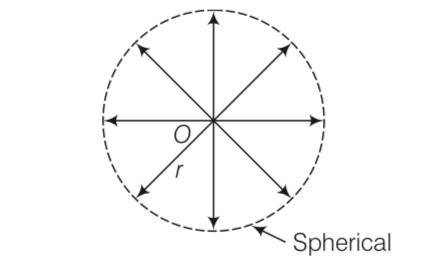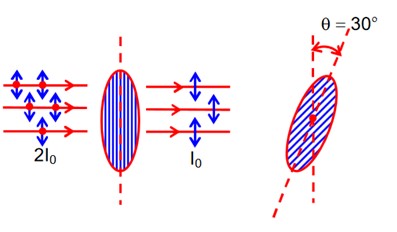For light diverging from a point source,
(a) The wavefront is spherical
(b) The intensity decreases in proportion to the distance squared
(c) The wavefront is parabolic
(d) The intensity at the wavefront does not depend on the distance
For light diverging from a point source,
(a) The wavefront is spherical
(b) The intensity decreases in proportion to the distance squared
(c) The wavefront is parabolic
(d) The intensity at the wavefront does not depend on the distance
-
1 Answer
-
This is a Multiple Choice Questions as classified in NCERT Exemplar
Answer- (a, b)
Explanation- Due to the point source light propagates in all directions symmetrically and hence, wavefront will be spherical as shown in the diagram.

If power of the source is P, then intensity of the source will be I= p/4 2
where, r is radius of the wavefront at anytime.
Similar Questions for you
At lower end
Tension, T? = 2g = 20 N (due to the 2 kg block)
Velocity, v? = √ (T? /μ) = √ (20/μ)
Wavelength, λ? = 6 cm
At upper end
Tension, T? = (2 kg + 6 kg)g = 8g = 80 N (due to the block and the rope)
Velocity, v? = √ (T? /μ) = √ (80/μ) = √4 * √ (20/μ) = 2v?
Since frequency (f) remains the same:
f = v? /λ? = v? /λ?
⇒ λ? = λ? * (v? /v? )
⇒ λ? = λ? * (2v? /v? ) = 2λ?
⇒ λ? = 2 * 6 cm = 12 cm
β = λD / (d? + a? sinωt)
β? - β? = λD/ (d? - a? ) - λD/ (d? + a? )
= λD [ (d? + a? ) - (d? - a? ) / (d? ² - a? ²) ]
= 2λDa? / (d? ² - a? ²)
3d = 0.6mm
D = 80cm
= 800mm
Path difference is given by
BP – Andhra Pradesh = Dx
[for Dark fringe at P]
n = 0, for first dark fringe
first dark fringe is observed on the screen directly opposite to one of the slits]
The distance between two successive bright fringes is fringe width .
Taking an Exam? Selecting a College?
Get authentic answers from experts, students and alumni that you won't find anywhere else
Sign Up on ShikshaOn Shiksha, get access to
- 65k Colleges
- 1.2k Exams
- 687k Reviews
- 1800k Answers

